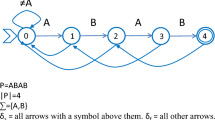Abstract
Some recognition problems are either too complex or too ambiguous to be expressed as a simple pattern matching problem using a sequence or regular expression pattern. In these cases, a richer environment is needed to describe the “patterns” and recognition techniques used to perform the recognition. Some researchers have turned to artificial-intelligence techniques and multistep matching approaches for the problems of gene recognition [5], [7], [18], protein structure recognition [13], and on-line character recognition [6]. This paper presents a class of problems which involve finding matches to “patterns of patterns,” orsuper- patterns, given solutions to the lower-level patterns. The expressiveness of this problem class rivals that of traditional artificial-intelligence characterizations, and yet polynomial-time algorithms are described for each problem in the class.
Similar content being viewed by others
References
Allen, F. E. Control Flow Analysis.SIGPLAN Notices,5 (1970), 1–19.
Arbarbanel, R. M., P. R. Wieneke, E. Mansfield, D. A. Jaffe, and D. L. Brutlag. Rapid Searches for Complex Patterns in Biological Molecules.Nucleic Acids Res.,12(1) (1984), 263–280.
Brzozowski, J. A. Derivatives of Regular Expressions.J. Assoc. Comput. Mach.,11 (1964), 481–494.
Barley, J. An Efficient Context-Free Parsing Algorithm.Comm. ACM,13(2) (1970), 94–102.
Fields, C. A., and C. A. Soderlund. gm: A Practical Tool for Automating DNA Sequence Analysis.CABIOS,6 (1990), 263–270.
Fujisaki, T., T. E. Chefalas, J. Kim, C. C. Tappert, and C. G. Wolf. Online Run-On Character Recognition: Design and Performance.Internat. J. Pattern Recognition Artificial Intelligence,5 (1991), 123–137.
Guigó, R., S. Knudsen, N. Drake, and T. Smith. Prediction of Gene Structure.J. Mol. Biol.,226 (1992), 141–157.
Hecht, M. S., and J. D. Ullman. A Simple Algorithm for Global Dataflow Analysis Problems.SIAM J. Comput.,4(4) (1975), 519–532.
Hirst, S. C. A New Algorithm Solving Membership of Extended Regular Expressions. Draft.
Hopcroft, J. E., and J. D. Ullman.Introduction to Automata Theory, Languages, and Computation. Addison-Wesley, Reading, MA, 1979, Chapter 2.
Kasami, T. An Efficient Recognition and Syntax-Analysis Algorithm for Context-Free Languages. AFCRL-65-758, Air Force Cambridge Research Laboratory, Bedford, MA (1965).
Lapedes, A., C. Barnes, C. Burks, R. Farber, and K. Sirotkin. Application of Neural Networks and Other Machine Learning Algorithms to DNA Sequence Analysis. InComputers and DNA, SFI Studies in the Sciences of Complexity, vol. VII (Eds. G. Bell and T. Marr). Addison-Wesley, Redwood City, CA, 1989.
Lathrop, R. H., T. A. Webster, and T. F. Smith. Ariadne: Pattern-Directed Inference and Hierarchical Abstraction in Protein Structure Recognition.Comm. ACM,30(11) (1987), 909–921.
Lectures and Discussions. Workshop on Recognizing Genes. Aspen Center for Physics, May–June, 1990.
Myers, E. W., and W. Miller. Approximate Matching of Regular Expressions.Bull. Math. Biol.,51(1) (1989), 5–37.
Needleman, S. B., and C. D. Wunsch. A General Method Applicable to the Search for Similarities in the Amino Acid Sequence of Two Proteins.J. Mol. Biol.,48 (1970), 443–453.
Sankoff, D. Matching Sequences Under Deletion/Insertion Constraints.Proc. Nat. Acad. Sci. USA,69 (1972), 4–6.
Searls, D. Investigating the Linguistics of DNA with Definite Clause Grammars.Proc. North American Conf. on Logic Programming, vol. 1, 1989, pp. 189–208.
Stormo, G. Computer Methods for Analyzing Sequence Recognition of Nucleic Acids.Rev. Biophys. Chem.,17 (1988), 241–263.
Wagner, R. A., and M. J. Fischer. The String-to-String Correction Problem.J. Assoc. Comput. Mach.,21(1) (1974), 168–173.
Wagner, R. A., and J. I. Seiferas. Correcting Counter-Automaton-Recognizable Languages.SIAM J. Comput.,7(3) (1978), 357–375.
Younger, D. H. Recognition and Parsing of Context-Free Languages in Timen 3.Inform, and Control,10(2) (1967), 189–208.
Author information
Authors and Affiliations
Additional information
Communicated by E. W. Myers.
This work was supported in part by the National Institute of Health under Grant ROI LM04960 and by the Aspen Center for Physics.
Rights and permissions
About this article
Cite this article
Knight, J.R., Myers, E.W. Super-pattern matching. Algorithmica 13, 211–243 (1995). https://doi.org/10.1007/BF01188587
Received:
Revised:
Issue Date:
DOI: https://doi.org/10.1007/BF01188587




